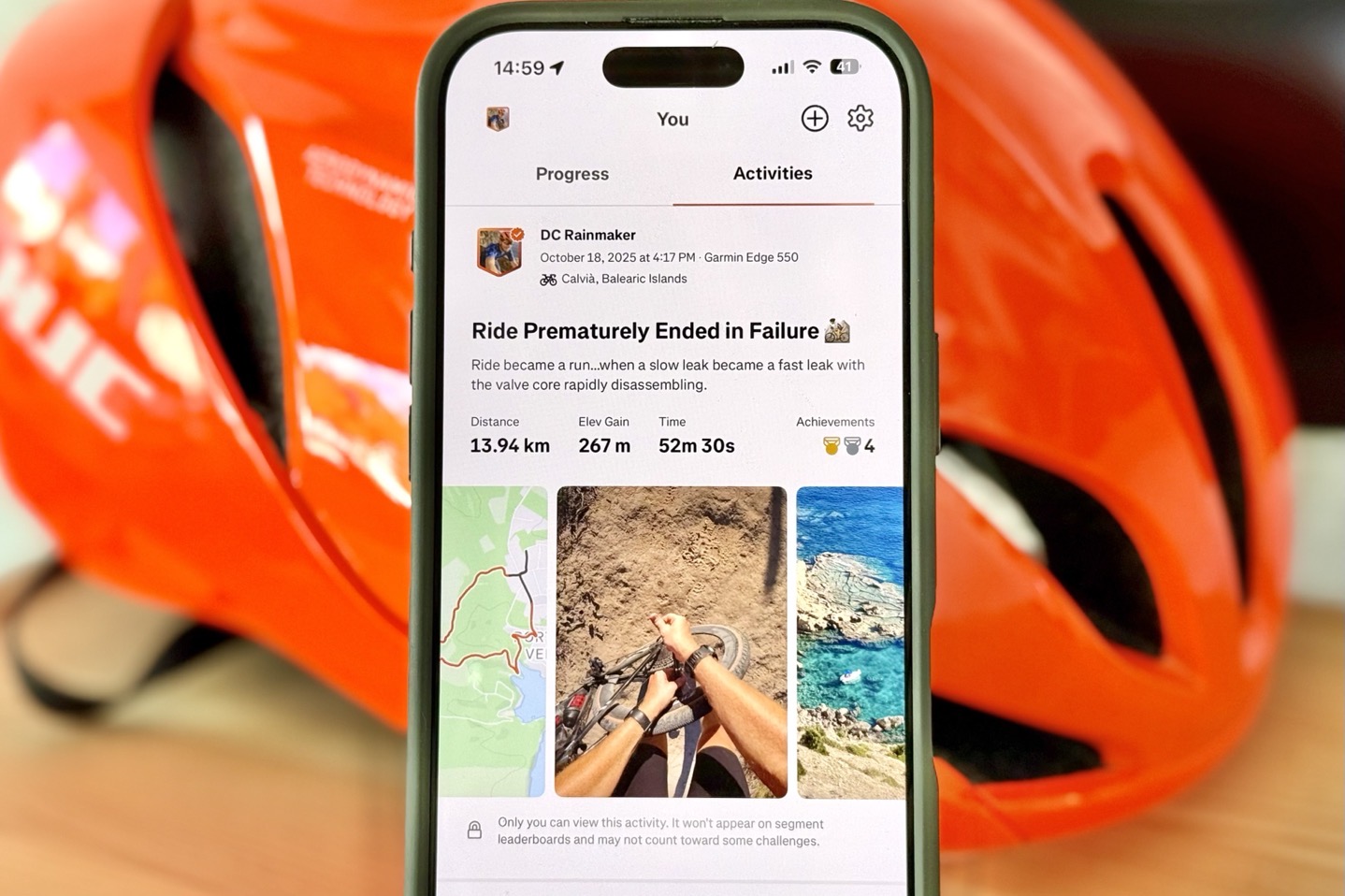
Almost exactly one year after Strava began a campaign to reel in 3rd-party apps, the company itself had to comply with new rules imposed on it, as a direct result of that very campaign last year. Rarely has there been such a pristine example of the phrase “what comes around goes around”. Except, of course, it ended way worse for Strava once you account for the lawsuit fiasco.
In any case, Strava began marking not just Garmin activities, but all activities with the data source. This was to comply with new rules that Garmin announced as of July 1st, 2025 in reaction to Strava’s 3rd-party app changes last fall. These updated Garmin API rules required most apps to comply by November 1st, 2025. Note that these rules only impact apps that have a direct connection to Garmin’s data synchronization service. They do not affect you as a consumer directly, for example, if you simply upload your files elsewhere.
These new API rules were, according to Strava itself, the reason why they filed a lawsuit against Garmin 30 days ago for patent infringement, only to then ultimately drop the lawsuit last week. We’ll set aside the fact that they spent those 21 days becoming the laughingstock of the financial & investor world, sports tech world, and legal folks alike. Let alone what consumers thought, and the subscriber losses there.
Unquestionably, filing that lawsuit hardened Garmin’s November 1st API policy deadline for Strava, one that the company has previously said they were flexible on for other companies (if they showed they were working on it). Had Strava not complied with the updated API terms, Strava claimed Garmin would cut them off. That move would have meant no Garmin user data flowed to Strava automatically, nor things like Strava Routes back to Garmin. Effectively giving no reason for any Garmin user to pay Strava, and almost certainly would have caused Strava to have massive business difficulties in a matter of days.
In any case, Strava had to simply attribute any activities coming from the Garmin API as being Garmin-sourced. Despite Strava’s executives misunderstanding the one-page PDF document with illustrations, it did not require a Garmin logo. It merely had to say the word ‘Garmin’ in cases where data was sourced. Note that previously Strava already listed the device type in a number of places. This just put it in more places.
Here’s an example of a screenshot I just happened to take two weeks ago of Shane’s seemingly dumpster fire of an activity (ok, maybe it’s a car, but either way, seems appropriate here), which notably does not show the device type. Whereas as of yesterday, you’ll now see the device listed (Garmin Edge 850), in the header:
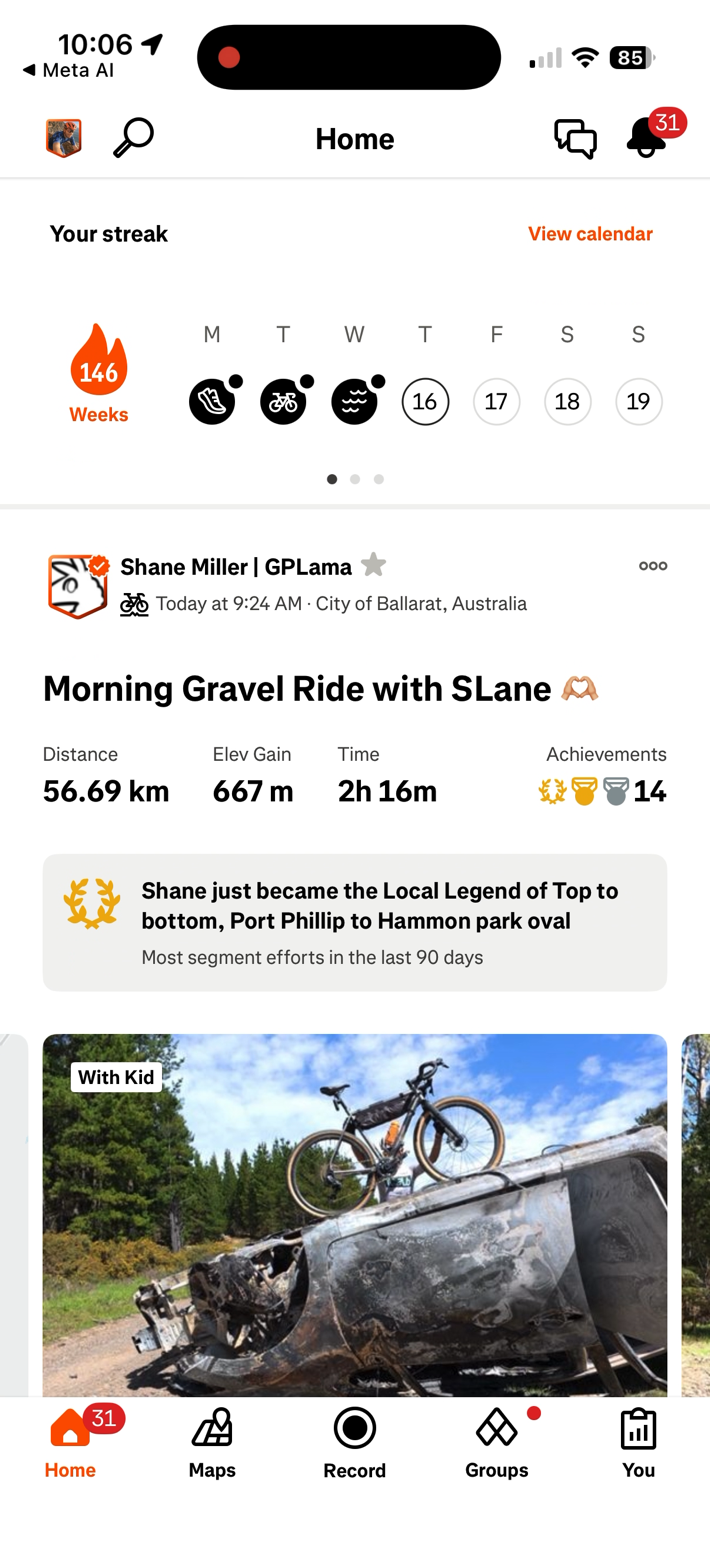
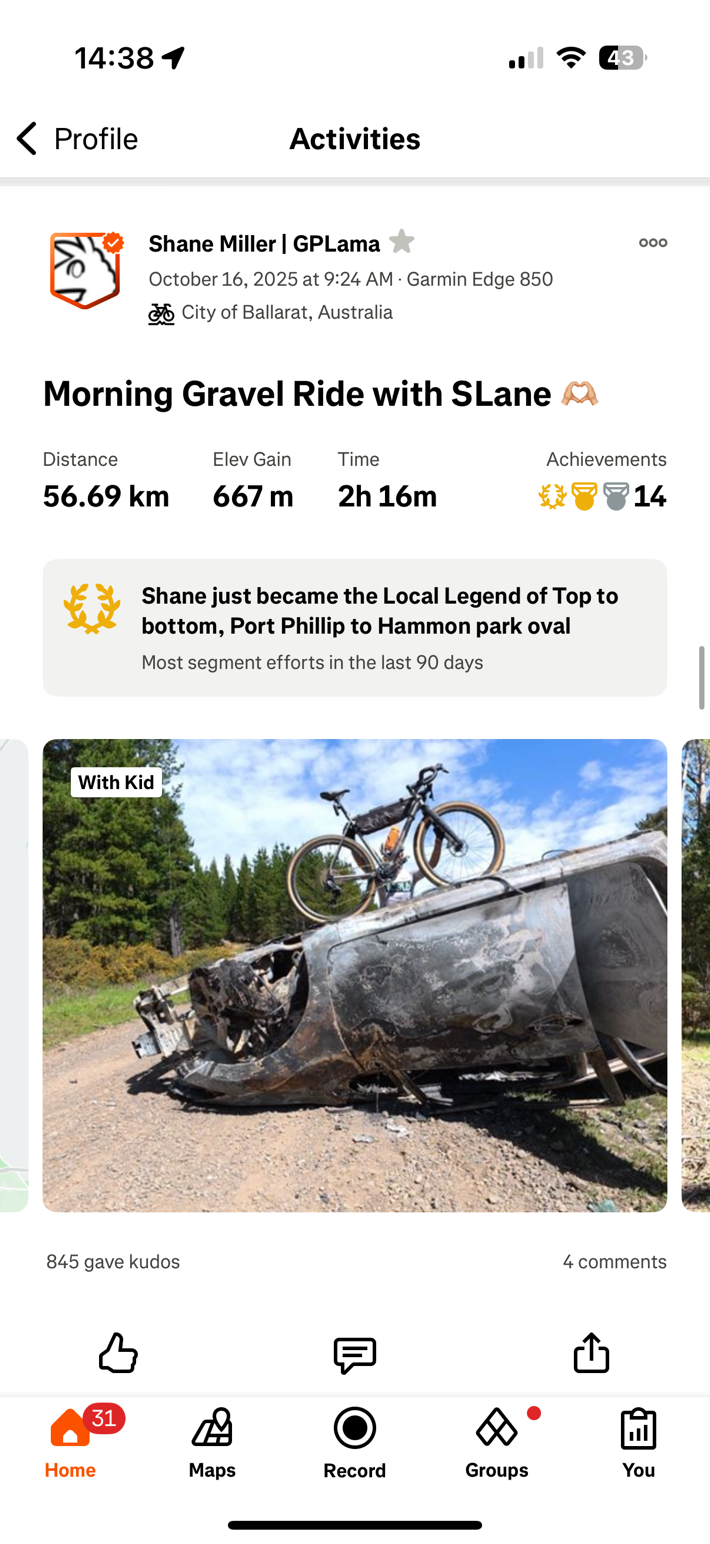
(Before at left, after at right)
Beyond that, the device is still shown where it always was, once you open up a given activity, directly below the main block of stats. Here are some relevant examples, showing non-Garmin devices as well. Strava had stated they will be complying with not just Garmin’s requirements, but also adding in attribution for all data sources (ironically, it does seem to be missing in the headers from their also-orange friend, Zwift):
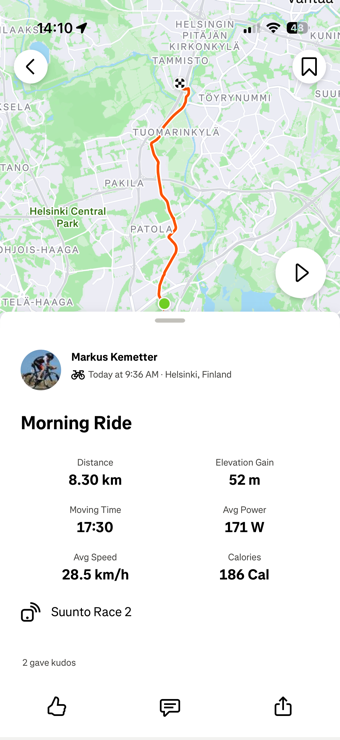
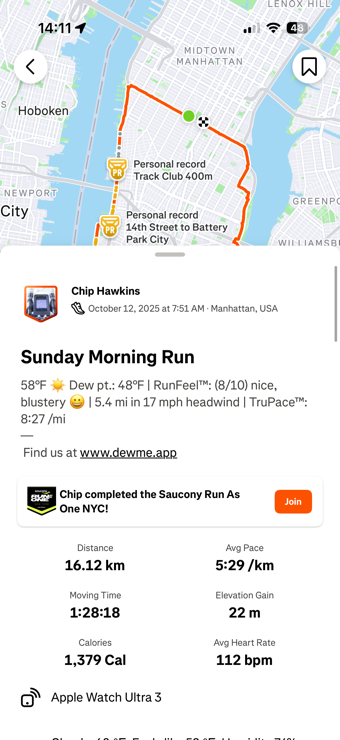
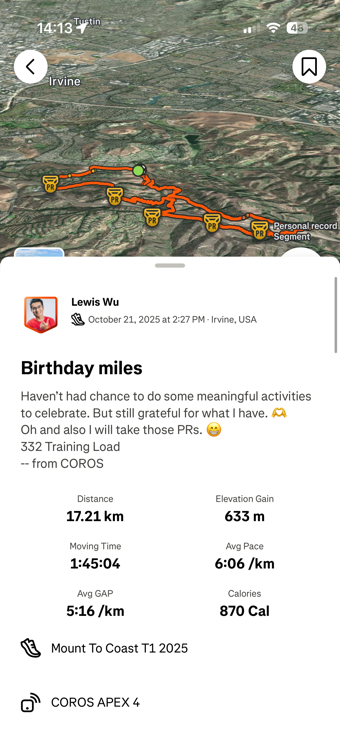
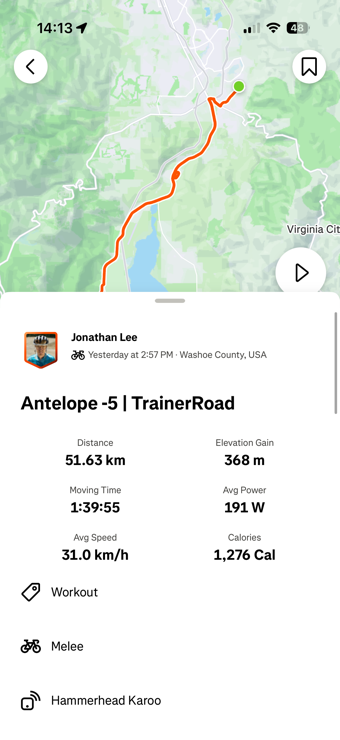
Additionally, attribution doesn’t seem to show on any other data pages, such as these data pages:
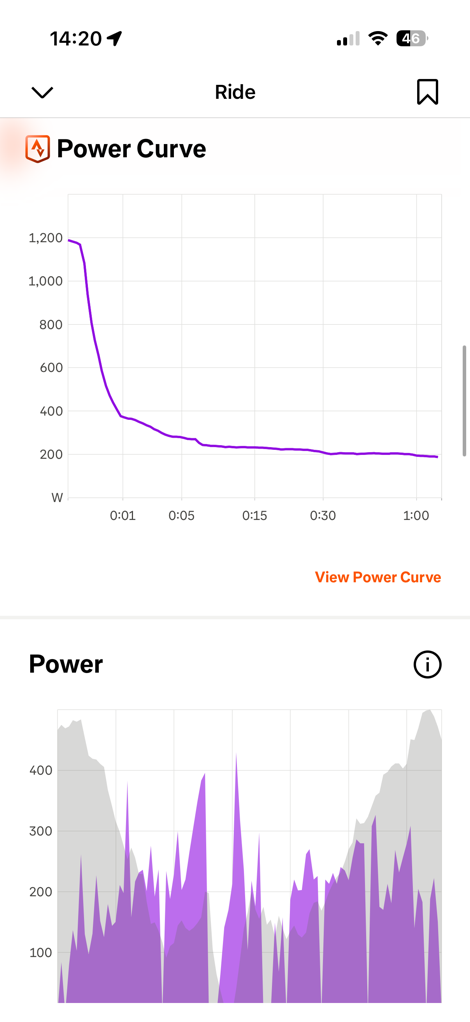
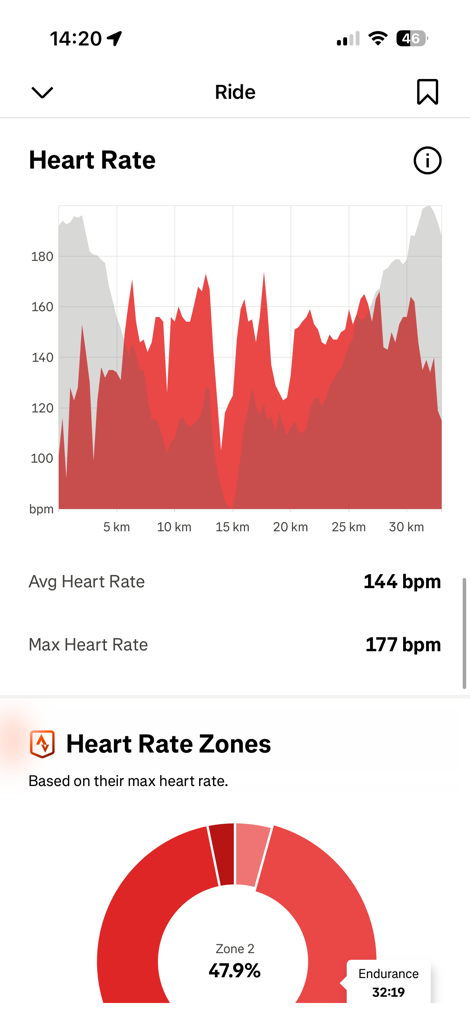
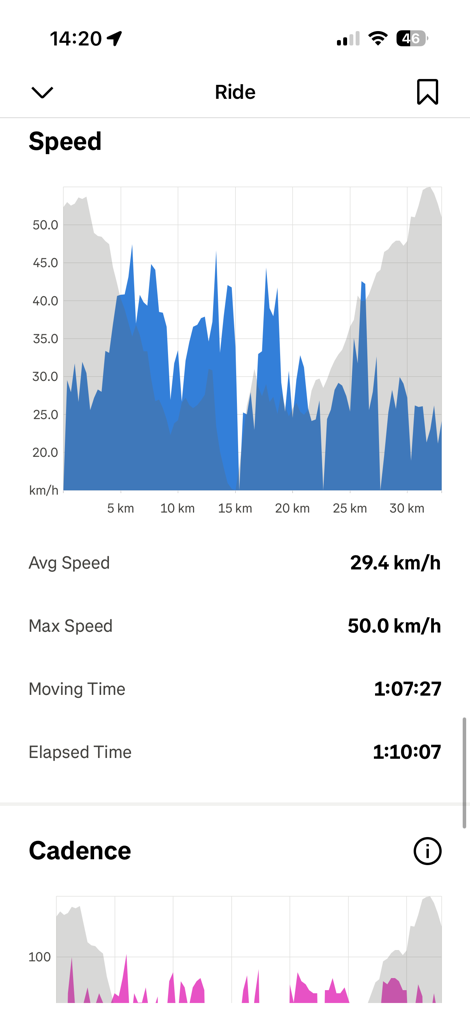
Apparently, Garmin & Strava came to some agreement there (temporary or otherwise), as the above is a bit different than the attribution examples Garmin has, which show it below most charts (example from their PDF below):
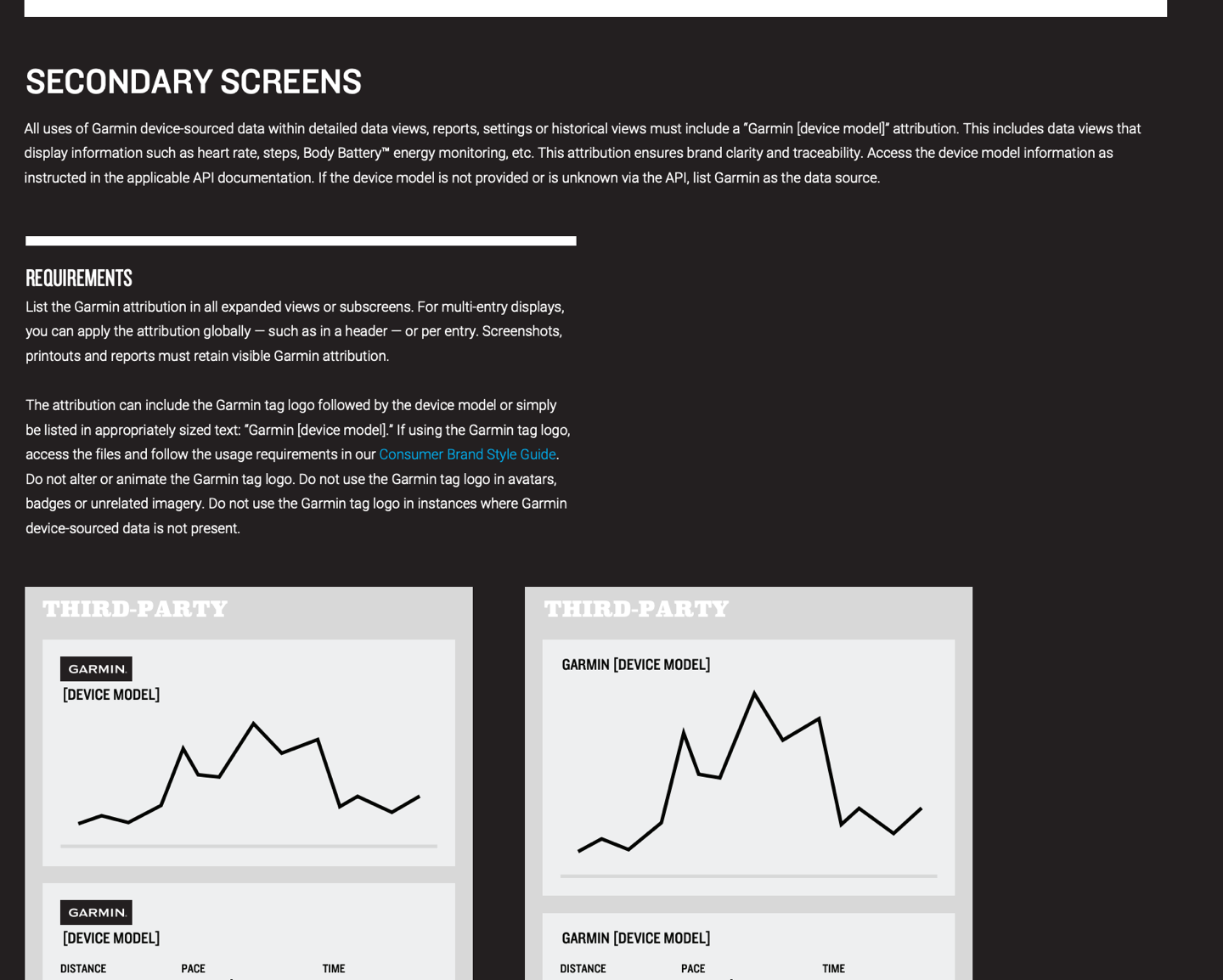
In talking to a number of smaller apps over the past few weeks, all of them have said that discussions with Garmin have been quite good and reasonably flexible. All of the ones that have talked to me have said the requirements, while not exactly something they wanted to put on their to-do lists, weren’t onerous, difficult, or a big ask.
That said, all of them (every single one of them) expressed the same concern, which is what happens when other companies start asking for attribution as well. For example, Garmin covers multi-sourced data charts, to a degree, here:
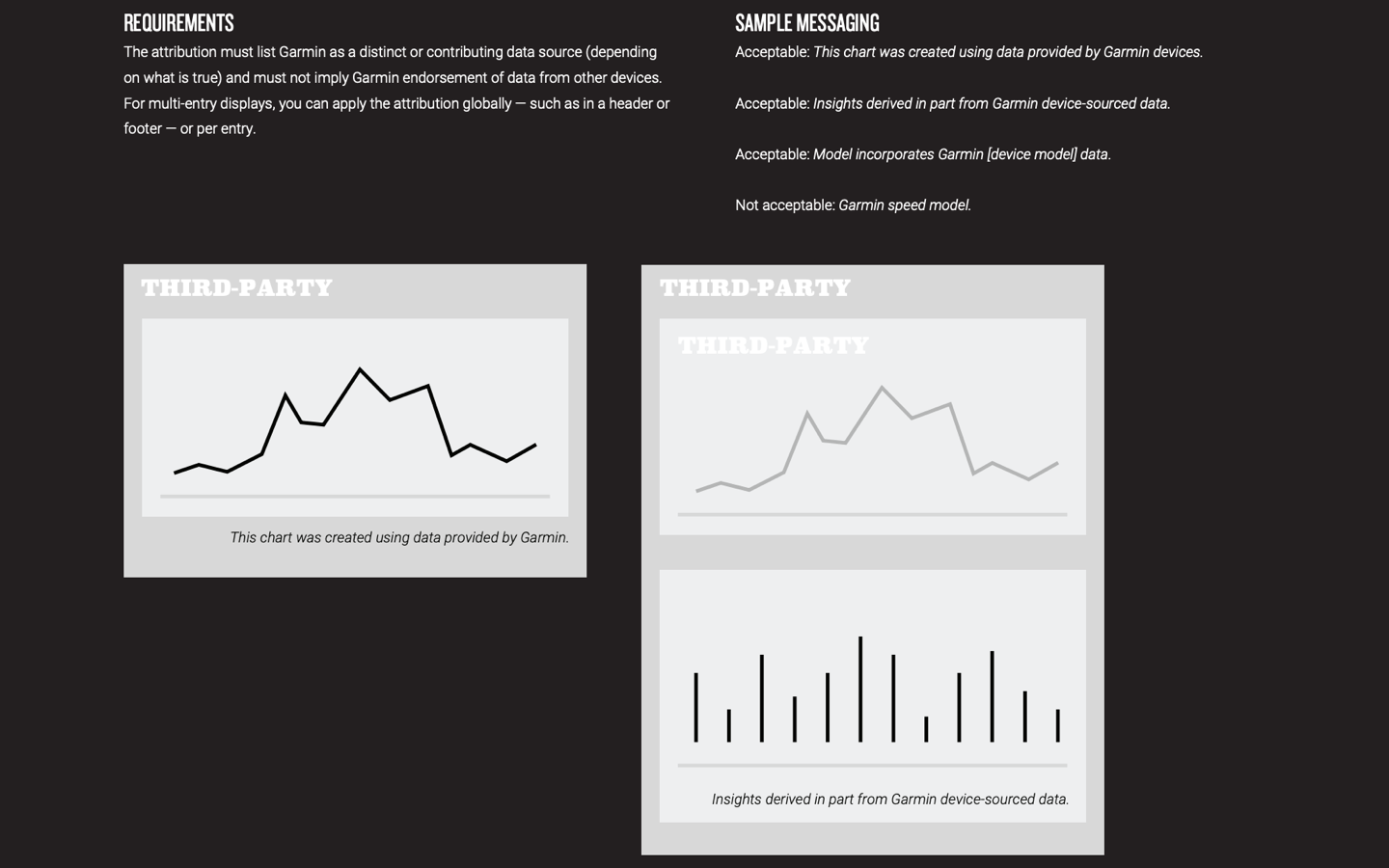
The problem comes, though, when you have an app that uses multiple data sources to provide unique insights. Does it become: “Insights derived in part from Garmin device data, Whoop device data, Apple device data”. And per Garmin’s API, that in theory means every single chart, which is just over-the-top ugly.
I fully get that Strava started this fiasco, and now everyone else has to live with the repercussions of it. All of which sets aside the fact that it’s ultimately the user’s data – not Strava, not Garmin, or anyone else. Sure, the apps are using that API connection, but I’m not convinced that long-term this is going to work, once other companies follow the lead (which they invariably will). It just becomes alphabet soup then.
In any case, until then, thanks for reading!
FOUND THIS POST USEFUL? SUPPORT THE SITE!
Hopefully, you found this post useful. The website is really a labor of love, so please consider becoming a DC RAINMAKER Supporter. This gets you an ad-free experience, and access to our (mostly) bi-monthly behind-the-scenes video series of “Shed Talkin’”.
Support DCRainMaker - Shop on Amazon
Otherwise, perhaps consider using the below link if shopping on Amazon. As an Amazon Associate, I earn from qualifying purchases. It doesn’t cost you anything extra, but your purchases help support this website a lot. It could simply be buying toilet paper, or this pizza oven we use and love.








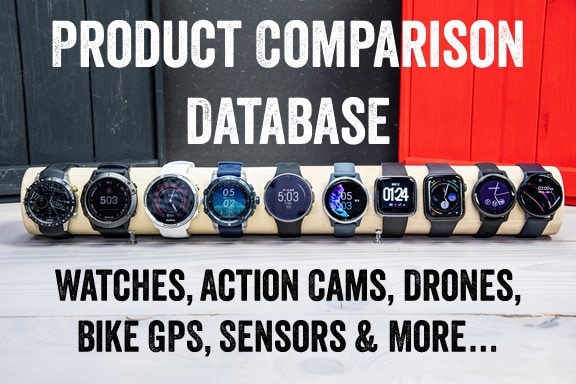
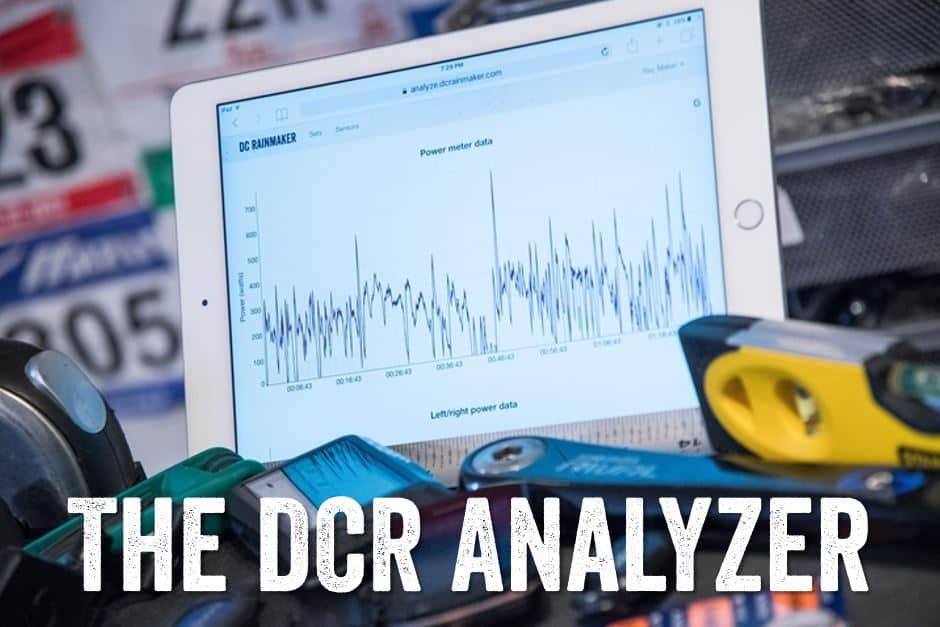



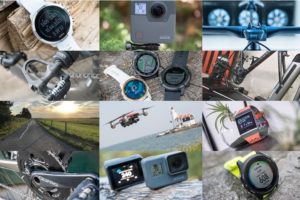
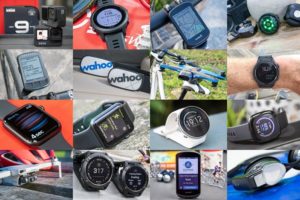



My “garmin connect” and Strava are not linked. I upload my fit files manually, and the activities are also attributed with “Garmin Edge 530”. So it does not seem to be a special garmin-Api attribution.
It’s in the fit tile that you upload
Correct. Strava is (logically) making their life easier here. The fastest path to get this done (after delaying for 4 months), would have been to simply take the existing device name attribution they’ve had in place for half a decade or something, and just enumerate it other places.
That existing attribution looks at the source file itself (the .FIT file, etc…). The naming of devices there is actually manual, interestingly enough, where it has to be on an ‘approved’ list to show up. Meaning, if you were to manually modify your device to show “Garmin Edge FOMO” instead of “Garmin Edge 550”, it won’t show “Garmin Edge FOMO” on Strava, but will instead show nothing at all.
It’s how you can see whether a device is released or not, when various sports tech folks upload it. As unreleased devices aren’t added to the Strava device registry until a company manually requests Strava do it. ;)
Unless I’m missing something, there isn’t a device name (as a textual string) per se in the FIT file, there’s a device numerical ID.
The device ID needs to be mapped to a human-friendly name on Strava’s side. This is why it takes a while after a new Garmin device is released for Strava to start attributing it.
So you couldn’t literally change the device in the FIT file to be “Garmin Edge FOMO” unless there was an actual numerical ID corresponding to that hypothetical device. You can change the device in the FIT file to any numerical ID, including an IDs that is unassigned and/or Strava doesn’t know about.
You can verify what I’m talking about by exporting an activity FIT file and opening it in fitfileviewer dot com. In the File ID table, you will see a human-friendly rendering of the product (device) field. In my case, it says “fr955” (for activities recording with my Forerunner 955). But if you click on the toggle in the upper right hand corner to change to Developer Mode, you will see that the actual value for the product field is a number (in my case, 4024 for Forerunner 955).
So it goes beyond “approving” device IDs – Strava needs to know the human-friendly / textual name corresponding to any numerical device ID it sees in a FIT file. Strava obviously can’t just display the numerical ID which would mean nothing to users.
You will also see that various tools for changing the FIT device ID always ask you to select from a *list* of devices, rather than entering a free text name. Again this is because it’s just a number, it’s not actually a free text string.
One such tool for changing the device in a FIT file is at fitfiletools dot com.
You will see there are 2 dropdowns for the device changer tool: manufacturer and device type. These correspond to 2 *numerical* fields in the File ID section of the FIT file.
The combination of manufacturer and device type is should uniquely identify a product from some company such as Garmin.
So to clarify my example above, for my FR955:
– the manufacturer ID is 1 (Garmin)
– the device type is 4024 (FR955)
Presumably any other manufacturer could use 4024 for a different model as long as they also use a different manufacturer ID (which ofc they would do).
Yes, the point of my explanation above though, was that while you could technically tweak the file to pretend it’s something else from within the existing data set, you can’t just make-up things that aren’t in the registry already.
My secondary point was that the process was (and still is) very manual. Mostly on purpose.
So to be absolutely clear companies aren’t just manually requesting that Strava show a new device because Strava is being unreasonable or lazy, they literally have to tell Strava the human-friendly name corresponding to the numerical device ID of a newly released device.
For example, when FR955 was released, Strava would have no way to know that a device ID of 4024 (never before seen) corresponds to “Forerunner 955” unless Garmin either reached out and told Strava, or if Garmin had some central registry [*] mapping device IDs to product names that Strava could access.
[*] they kinda do, in the form of the FIT profile, except that’s not updated frequently enough, and it only maps device IDs to programmer-friendly names (like “fr955”) as opposed to user-friendly names (like “Forerunner 955”)
So to me the requirement for companies to tell Strava about new devices (i.e. to tell Strava that a new numerical device ID corresponds to a new product with a given human-friendly name) is not at all due to any kind of unnecessary policy on Strava’s side, but it’s a necessary consequence of the fact that the FIT file only stores numerical manufacturer/product IDs and not human friendly strings. (FIT was created a long time ago, when device storage constraints were pretty tight, and it seems to me that it was designed with the idea that every byte matters. I’m not criticizing this at all, but just explaining why I think it is the way it is.)
The other alternative would be for all the companies that use FIT to contribute to a single centralized repository mapping device IDs to human-friendly names. This isn’t impossible, but someone would have to maintain and govern that site.
Yes but I wanted to elaborate that it isn’t just a policy on Strava’s end, it’s technically impossible to make up some random device, because the device names (and manufacturer names) themselves aren’t stored in the FIT file at all.
It’s just numbers, so if you made up some random numbers for the manufacturer and/or device name, there would be no way to map them to something to be displayed to the user.
Iow it’s not just a stubborn / lazy / onerous policy on Strava’s end, it’s a consequence of the FIT file design.
> My secondary point was that the process was (and still is) very manual. Mostly on purpose.
Again this cuts to heart of my point. In both of your comments it seems you’re implying things could have been different. i.e. That Strava could have chose to automatically attribute new devices, as opposed to having companies reach out and ask them to.
No, I’m saying it’s impossible – by Garmin’s FIT design/implementation.
Unless, again, all the companies agreed to contribute to a centralized repository of device ID to device name mappings, which would be more work for everyone than the current way (probably).
It would be nice for 3rd party devs though. Right now the only public repository of mappings only refers to programmer-friendly names, which is fitfileviewer shows “fr955” for my watch and not “Forerunner 955”.
> Unless, again, all the companies agreed to contribute to a centralized repository of device ID to device name mappings, which would be more work for everyone than the current way (probably).
(to be clear, again I mean human friendly device name mappings, and not just the programmer friendly mappings in the FIT profile.)
Well, it would probably be more work for whatever body would set up the repo (like Garmin). Once it was up and running, it might be easier for everyone else.
Maybe it would be easier if Garmin only set up the repo for its own products.
Either way, I don’t think any such repo exists (public or private), otherwise Strava could easily use it.
Yeah, I think you might be misreading my comments. I’m not at all implying that this is a bad Strava problem. There’s lots of mostly good reasons why this exists.
I’ve talked about this for years. The only blame I will lay on Strava here is that, for a period (including till semi-recently), Strava got pretty far behind on getting some of these added. Whereas in the past, it used to be the day after a device was released (if not the same day). That person was very close to these partners, and had devices ahead of time, dates confirmed, etc… They’re not there anymore, and as a result things seem a wee bit more delayed. Sometimes a lot, sometimes a little. That’s all.
Ok, that’s fair. Sorry for the misunderstanding.
It does seem to me that in the first comment, you were implying that when a new product released, the text of the device name (such as “Forerunner 970”) is inserted in the FIT file, and Garmin has to go ask Strava to approve the new name (“Forerunner 970”). But that’s not how it works.
All I’m saying is that, actually, when a new device is released, Garmin (or any other manufacturer) just picks a new / unassigned numerical device ID (e.g. 4024 for Forerunner 955), and they have to go tell Strava: “hey guys, fyi 4024 means ‘Forerunner 955′”
Going back to this comment:
> Meaning, if you were to manually modify your device to show “Garmin Edge FOMO” instead of “Garmin Edge 550”, it won’t show “Garmin Edge FOMO” on Strava, but will instead show nothing at all.
No one can *literally* modify the device info in the FIT file to show “Garmin Edge FOMO”.
That was the starting point for all of my comments.
Actually, you can modify the device info to use some other numerical device ID. If numerical device ID corresponds to a known device, obviously Strava will show it. If the numerical device ID doesn’t correspond to a known device, obviously Strava couldn’t show the device name *even if they wanted to*, because there is no device name corresponding to that numerical device ID.
All I’m saying is that all of this goes beyond a choice on the part of Strava, it’s a necessity based on the technical details of how this information is stored in the FIT file.
Sorry if it seems like nitpicking / reading into your comments, I just wanted to clarify how it actually works.
Thanks for engaging with my comments and thanks for everything you do! Honestly you’re the best big source for this stuff in a sea of clickbait and low-effort “journalism”.
Is this covered in the new requirements? As in, is there anything stopping malicious compliance? If Ray uploads* a file in “about a year” and Strava mark it as “probably Fenix 9” or “unreleased Garmin watch” would that be against the rules?
*for example. Pretty sure Ray would catch that and stop uploading. I’ve yet to see a slip up but as an example I think it shows what could go wrong.
The requirements state that if a device name is unknown or not provided by the API, then the attribution can be just to generic Garmin data source.
“If the device model is not provided or unknown via the API, list Garmin as the data source.”
In a fictional Fenix 9 scenario, since Garmin provides those names, and almost always does so upon release (these days), there’s virtually no scenario where a file is matched to a name that doesn’t yet exist. Even more so given these are heavily brand-specific names. For example, a friend has an Epix upload, and it’s listed as, specifically: “Garmin epix Pro (Gen 2) 47mm”
> there’s virtually no scenario where a file is matched to a name that doesn’t yet exist.
Sorry I have to disagree.
As I mentioned above, every time a new Garmin device (like a watch) is released, there’s a flurry of complaints from users that their device is not (yet) attributed in their Strava activities.
The response is always: wait a few days, Strava will fix it.
e.g. link to reddit.com
I’ve seen this exact complaint multiple times over the last years, on both reddit and Garmin forums.
I know that you qualified your statement with “these days”, but I’ve seen these complaints as recently as Fenix 8, iirc.
Here’s one from 8 months ago (Instinct Solar 3):
link to reddit.com
Btw, for anyone who is interested, here is what the form looks like for manufacturers who want to add a new device to the registry.
link to form.asana.com
And a support request from a smaller company on the same topic (where Strava support tells them to fill out the form above):
link to communityhub.strava.com
> The response is always: wait a few days, Strava will fix it.
I mean the response from random community members. They may or may not clarify that it’s actually Garmin which needs to provide the appropriate info to Strava.
I think you’re misreading what I was talking about.
I was responding to the very specific scenario of someone trying to spoof a futurist Fenix 9, and getting it to show up. My point is that you literally can’t do that, because Garmin hasn’t given Strava the ID’s yet to match to whatever that formal name is. It’s simply not called “Fenix 9”, but actually called by some more official sounding SKU (usually including the size/variant/etc…).
My secondary point that I’ve made repeatedly, is that inversely, in the past, that happened within a few days of release, whereas more semi-recently (most of the last year), there were times it took like weeks to a month to show up. Whereas I noted that most recently, it was showing up in a week or so.
Above, I noted why that shift has been more obvious.
Well, that explains why some activites uploaded by non-standard watch app showed up unattributed. They didn’t even tag it to Apple Watch like some of the others.
Sorry, my mistake!
> My point is that you literally can’t do that, because Garmin hasn’t given Strava the ID’s yet to match to whatever that formal name is.
Haha that was my original point in the other thread, but obviously we are in violent agreement.
But I will note that the *formal* name distinction doesn’t matter, since Strava could not even display an informal name if it wanted, since it’s a numerical device ID that’s stored in the FIT, not even an informal name / programmer-friendly textual ID.
> My secondary point that I’ve made repeatedly, is that inversely, in the past, that happened within a few days of release, whereas more semi-recently (most of the last year), there were times it took like weeks to a month to show up.
> Whereas I noted that most recently, it was showing up in a week or so.
Sorry to nitpick but again I will quote your comment:
“almost always does so upon release (these days), there’s virtually no scenario where a file is matched to a name that doesn’t yet exist”
“Upon release” makes it sound like Garmin instantly informs Strava of a new device ID, and Strava instantly updates their database. Whereas in reality, it takes anywhere from a few days to a few weeks, as you noted.
So actually, there is a scenario where an (activity FIT) file (that’s uploaded to Strava) corresponds to to a name that doesn’t yet exist: the first few days/weeks after a new watch is released. And it happens pretty much every time.
Again, it may not have been your intent to claim that there’s no period of time in which uploaded activities cannot be attributed by Strava because the device is too new, but even with the context of the comment you are replying to, that’s how it comes across.
Maybe I’m still misreading what you mean by “is matched to” though.
If by “is matched to” you mean that Strava could/would literally display a name of an unreleased/unknown watch, that’s obviously *impossible*, not just “virtually” impossible, unless Strava were to guess which name (formal or not) corresponds to a given unknown device ID. Ofc there are many reasons they would not want to do that.
If by “is matched to” you mean that a device ID is simply unknown, but in fact in corresponds to some new device (which Strava isn’t aware of yet), this happens all the time.
Also, in the case that Strava sees a new device ID for which they don’t have a mapping yet (which again, happens every single time that a new Garmin device is released, and users buy it on release and upload activities), it would certainly be possible for Strava to display “new/unknown Garmin device” (or something like that) [*], but I can think of a few reasons they have chosen not to do that. (Probably because it would look fairly bad on them.)
[*] Since the numerical manufacturer ID (1) still corresponds to Garmin, even if the device ID is unknown.
I noticed that my wife’s device is attributed as “Garmin epix Pro (Gen 2) 42mm” buy mine is “Garmin fēnix 8”. But in Garmin Connect it is “fenix 8 – 51mm, AMOLED”.
This doesn’t matter very much but it’s weirdly inconsistent that it is hyperspecific for the epix and super-generic for fenix 8: no size or display type differentiation.
My “probably Fenix 9” point wasn’t that a user could do it, more that Strava could have changed the tag for an unknown device while you’re testing since the device name had yet to be released. Even writing “unreleased garmin” confirms a new watch is on the way.
Since it’s covered in the rules it’s kind of moot anyway but it would have been fun to see Strava poke back a bit.
In Strava’s defence: it is just extra, useless text/clutter that feels like mandatory frontpage advertising. At least the way it’s implemented now.
You don’t understand then why this was done. Last year STRAVA demanded that all of the applications pulling data from Strava follow extremely strict rules for what Strava was terming as “Strava Data”. But most data on Strava is not FROM Strava. Its from everywhere else. So why should Strava dictate what other applications do with, say, my Garmin data.
This makes it abundantly clear that the data that they are trying to claim as their own, is not in fact, theirs.
Well said!
Maybe it’s just me, but I feel the overall point that’s missed by most who are following this Garmin-Strava catfight is that 2 companies with millions of users are *both* laying claim to data that should rightfully “belong” to the users themselves.
Yeah, Strava wouldn’t exist without Garmin, but Garmin wouldn’t exist without its users.
Yet both Strava and Garmin want to use all of our data to create services and devices that they then sell back to us.
One example could be Garmin Trails, the new Connect+ only feature. I don’t do trail runs, but I heard that when a Garmin user runs a trail, sometimes they will be prompted to review the trail for the purpose of the Garmin Trails feature. I *think* this happens even for non-Connect+ users. So Garmin is not only passively using user data for Garmin Trails, but actively soliciting content from users so they can sell it back to them.
Hey I get it. It’s not like any individual Garmin or Strava user can create a service utilizing the data of millions of people just like us, and let’s face it, appropriating the data of us users to sell it back to us (or sell it to 3rd parties) is the business model for pretty much every tech company. AI is an extreme example of this.
I just don’t think there are any “good guys” in this fight.
2 wrongs do not make a right. Yes Strava deserves, but Garmin is doing this (forcing device names) to get people to upgrade their watches.
How in the world do you come to that conclusion? If I, for example, use my old original Fenix for an activity, is Strava going to show, instead of “Fenix”, something like “you should be ashamed to use a device that old”? I don’t see how Garmin is forcing people to upgrade their watches this way.
> I don’t see how Garmin is forcing people to upgrade their watches this way.
I mean, I’d have to say that anyone who feels shamed into upgrading their device this way kinda deserves what they get.
I got a FR955 (last Forerunner with MIP) on purpose, instead of a FR965. I can easily see that a lot of people in my training group and my races moved on to Garmin AMOLED, and I know that a lot of my more casual runner friends switched to Apple watch.
That doesn’t stop me from enjoying my FR955 for my own reasons (which I won’t go into here), while recognizing that that AMOLED (for example) is better for a lot of use cases, and that MIP has looked “old” for 10+ years. (I know that users have been complaining about MIP for at least 10 years, if not longer.)
If I could win a race outright or my age group while rocking an old Forerunner like some of my friends/acquaintances, to me that would make having an old watch something to be proud of, not something to be ashamed.
I get that all things being equal, some people do have to have the latest and greatest tech. Idk how many people who are on the fence are suddenly gonna be pushed over with this device attribution change. Maybe a tiny number of people, but I don’t see massive waves of people upgrading.
This is really kind of absurd.. all the people around me (and among them there are sub 9h performers for a full distance) use a motley assortment of-admittedly mostly Garmin- stuff we replace it once it is not longer usable but not because of a labeling in a social media platform. This whole dumpster fire Strava thing is kind of entertaining, but hopefully people return to training and going out there to compete because it is just plain old fashioned fun… the next startline is waiting, no matter what wearable is involved.
Is it possible to hide your device info from appearing on other people’s feeds? I guess it’s not hugely personal, but even so given all of Strava’s various privacy options, it seems odd that you can’t make device info private.
I’m not aware of any way to. There’s ways for people to hide other metrics (e.g. HR/power/etc…), but has never been (to my knowledge), any way to hide the device type.
(You can however use https://www.fitfiletools.com to remove it)
I wish, this way my wife wouldn’t know when I upgraded!
Can you *remove* the device type using fitfiletools or only change it?
I’m sure it would be possible in principle to create a tool that literally removes the device type field, but I’m not sure if Strava would accept the file in that case (maybe it would, but I’m not sure).
> it seems odd that you can’t make device info private
I kinda wanted this ability in the past. It seems to me that with this recent attribution saga, Strava has more reason than ever to *not* allow users to make device info private. In the past, they may have only been attributing data as a courtesy, but now they are def doing it in response to Garmin’s demands. I doubt Garmin would be cool with Strava allowing users to hide the thing that they just demanded Strava should display even more prominently and ubiquitously than before.
Strava needs to add in this feature.
Just checked – Lots of the people I follow are using Forerunners 35, 45 and 55’s. Garmin are pushing this not so much for free advertising, but this is the best method to get people to upgrade to more expensive watches.
I’m sure Garmin appreciates the free advertising, but equally so, it’s also showing all their competitor devices too – since Strava has selected (and been clear), that they plan to show all devices.
And again, all this stuff was showing previously just by opening it. This just makes it more obvious in the scrollable feed, specifically.
I’m not convinced this really drives people to upgrade older watches. It might make them aware of newer watches, but I’m pretty sure if someone has a FR735XT (as one person in my feed does), they’re pretty aware it’s an old watch.
Yep, the home feed is gone from look at my activity to look at my watch and activity. A lot of us, especially those that train consistently will not care, but are those that do a short run to post my new sneakers before race day not gonna care? Teens are not gonna care? I remember the sent from my iphone/blackberry days.
Adding in the option to hide device could also be a way for Strava to stick it to Garmin. Not that I am in favor of Strava’s API requirements.
> Just checked – Lots of the people I follow are using Forerunners 35, 45 and 55’s. Garmin are pushing this not so much for free advertising, but this is the best method to get people to upgrade to more expensive watches.
Can’t speak for anyone else but the reason I wanted the ability to hide my device is because I’ve used Forerunner 9xx watches for a while, and I always felt it was cringe to wear such an expensive because I’m “just” a runner, not a triathlete. (I like the 9xx line for some of the extra features.) If I could easily spoof my watch I’d probably change it to an FR255.
I know a few age groupers and sub-elites (one of whom who won an 8 miler outright recently) who still rock a FR235-era watch (or they did until 1-2 years ago). Same with micro-influencer types who were in the local media for stuff like running 1 marathon per week for a year (they’re fast enough to race around 3:00). I did know one micro-influencer 10 years ago who would post on FB about how great his Polar was. Not quite sure exactly how organic than what.
I don’t know if it’s the “best” way for Garmin to get people to upgrade. I’m sure they wouldn’t mind if some people get FOMO from their Strava feed.
Also, I don’t think the ideas of “free advertising” and “[getting] people to upgrade to more expensive watches” are necessarily mutually exclusive. (Although I get your point.)
> If I could easily spoof my watch I’d probably change it to an FR255.
By “easily” I mean while continuing to automatically sync with Strava. Ofc I’m aware I could just export my activity file manually, edit the device using a tool, then manually import the file.
Ofc I was being somewhat hyperbolic. I probably wouldn’t really spoof my device, but I def wouldn’t mind being able to hide it.
> Adding in the option to hide device could also be a way for Strava to stick it to Garmin. Not that I am in favor of Strava’s API requirements.
But again, why would they add this option *now*, after they have agreed to Garmin’s requirements?
Seems like it would at least violate the spirit of their agreement, and maybe even the letter.
Why go through all of this just to antagonize Garmin *again*?
Sorry, that’s a poor choice for the end user. You need to either manually edit every file or feel like you need to upgrade if you’re using old gear. There should be an option for the end user to turn off device easily.
> You need to either manually edit every file or feel like you need to upgrade if you’re using old gear
This is a false dichotomy.
You have the choice now (as you did before) to simply give zero Fs about the device name that’s displayed on Strava.
The fastest runners I know use FR235-era watches (10 years old at this point) or did so until 1-2 years ago.
I think the kind of person who cares the most about being judged for their watch either:
– already has the latest Garmin (of their own free will, not bc Strava forced them to upgrade by displaying the device name on their activity)
– has a recent model of Apple Watch, just like all the other normies who care about this stuff and aren’t in the Garmin niche
Also, this is such a ridiculous first world problem.
Running and other endurance sports are solidly upper-middle class pasttimes.
When I lived in a working class neighborhood (when growing up), there wasn’t a single running store. My best friend lived in a similar hood and he would joke that while he ran for exercise, nobody else runs unless they’re “running from the cops”. My hood was in the news multiple times over the years for multiples issues (crime and other systemic issues). Nobody ran outdoors for fun or exercise. Nobody organizes running races around that neighborhood either – when a 5k race was held recently in the general area, it was literally the first one in history.
Now I live in a nicer neighborhood and there’s multiple running stores. I can see this pattern in all the neighborhoods of my large North American city.
Sorry, from my pov, feeling like you’re obligated to upgrade to a new Garmin bc Strava is suddenly displaying the device name more prominently in your Strava feed is not a real problem. If you think your friends are gonna ostracize you or shame you for having an older Garmin, then idk what to tell you – get better friends.
I would say that pushing expensive Apple products on to ppl of all generations and income brackets (in North America) is more of a problem than this.
Anyone who owns a Garmin likely had the money to buy it in the first place, and nobody is forcing them to buy a new one – Garmin isn’t even a cool brand, outside of certain very niche subcultures.
“I would say that pushing expensive Apple products on to ppl of all generations and income brackets (in North America) is more of a problem than this.”
A lot of people will not be bothered by this, especially those that train consistently, like the pros. But like the people who are pressured into buying Apple products, there will be people that are pressured into upgrading their watches, especially amongst the younger generation. Should we not be trying to protect the younger generation?
“Anyone who owns a Garmin likely had the money to buy it in the first place, and nobody is forcing them to buy a new one – Garmin isn’t even a cool brand, outside of certain very niche subcultures.”
Strava is that place where Garmin is cool? Yes no one is being forced, but why did Garmin choose to have Strava specifically list the device name instead of just attribute the activity to Garmin or Garmin Connect?
Because it’s always been that way? Strava has always listed the device name, just not in the header.
And who is doing all this pressuring? Is that something that happens on TikTok? If you have a device that’s doing what you want and still works well, why upgrade?
If they just wanted brand recognition, why has Garmin forced Strava to attribute device names specifically, instead of just attributing to Garmin?
This is going back to the old Twitter days of sent from my iPhone. But even back then, they never listed model numbers.
I’d argue because, again, back to FAFO.
I’d say this is Strava doing the least possible to obey the requirement. Take a string they already have and repeat it, inconspicuously, in an another place. It’s not a giant flashing “buy Garmin!” label. I don’t know that I even would have noticed if I hadn’t read Ray’s post.
Once again, Strava deserves this, but I do not think we should be supporting Garmin here because of Strava’s crimes.
Even if someone created a competitor to Strava with a totally open API, they will have to follow these new API rules and plaster your device name everywhere?
Let’s say I am wrong about Garmin using this as a way to nudge older watch users to upgrade. How is this different from smartphones wanting to watermark your photos? Imagine if there was no setting to turn it off? Imagine if manufacturers argued that the info was already there in the metadata?
Well, this is a very North America centered view, isn’t it? I started back in 1984 after being galvanized by watching the Olympic Games. I trained in several sports before I became a Triathlete. Technology has come a long way since then. Me and my peers do explicitly not care whether a piece of equipment is cool. It just has to serve its purpose. I also own a metabolic cart and some other stuff I have access to as a physician. Is that in and of itself cool? No! Only the things that a person achieves can be cool, not some piece of equipment. Just my two cents here
This. When I saw it on Komoot, I was angry at them for making the change – I never wanted people to know what kind of device I use; if anything, it should be an opt-in (my data, after all). It was only a few days later I learnt it was Garmin’s doing. I partially understand where this is coming from, but more and more of our data is just out there and I’m not comfortable with it.
My fear is that all devices will be listed…
My GPS is a Garmin, my heart rate monitor is a Coospo…
Mercy…
“I fully get that Strava started this fiasco, and now everyone else has to live with the repercussions of it. All of which sets aside the fact that it’s ultimately the user’s data – not Strava, not Garmin, or anyone else. Sure, the apps are using that API connection…”
I totally agree with this, except maybe it was Garmin that started this fiasco. Strava, like you and me, just didn’t like it. 😉
Oh, this was definitely Strava starting it. Strava started it last fall, which upset Garmin. Garmin then started working on an attribution plan immediately after that, which was presented to Strava earlier this year (along with other apps), they went back and forth a while, and ultimately led to Strava suing Garmin.
Ha,, haha. Guess I didn’t know the whole history. Thanks for the correction.
Sad day for consumers. Unlike Google maps, you do not only have to attribute the data to Garmin, but the name of the device as well? This is sadly gonna peer pressure a lot of people to upgrade their watches.
Yes, this info was available before, but you had to go looking for it. Now it’s on the home page on every activity.
Too little too late for me and Strava, I cancelled my subscription (I had been a subscriber since day 1 of subscription) when the API fiasco started a year ago, then I went, well, it hasn’t hurt me too much, so I renewed it when it expired, but this lawsuit changed it again and its cancelled.
I’m a consumer, I don’t want this hassle, and in fact, when I look at the premium features, I don’t really use any, I’ve moved back to Garmin for route creation as an example.
If they change the exec’s who are making these stupid decisions (likely the CPO) I may renew, I guess what I mean by that, Starva start putting the customer first and not themselves, I will happily give them my hard earned cash, but today, they are not getting anymore.
Ray,
The interesting thing is that Strava doesn’t show attribution for the following scenario: Do a ride on TrainingPeaks Virtual, manually uploaded the ride FIT File to Garmin -> sync Garmin to Strava.
I only do the above because there isn’t a more elegant way to get the TrainingPeaks Virtual ride into both TrainerRoad & Apple Health
Yeah, I suspect there’s some cases that just haven’t been sorted yet.
Though, in that case, the originating file is coming from TrainingPeaks, and thus may not have the right data files or whatever populated to in turn populate the attributation.
For example, as noted above the Zwift ones aren’t showing up, and I think I didn’t see Rouvy properly tagged either in the headers (but does show lower down).
So far I’m seeing that if you run with friends, etc, it doesn’t say who used what in your feed.
Here’s one from 6 days ago that I saw on my feed:
Two or more runners run same route, no device attribution at top level. (If you drill down, it appears in the details.)
Yeah, appears to be lots of gaps here. As noted in the post, also gaps on charts and such.
My guess would be that Garmin & Strava came to an agreement in this area, at least temporarily, to sort things out. Ironically, that’s what Garmin said all the way back this past spring – that they’d work with companies that were making progress on the requirements, and give them more time/etc…
Are there no attributions for virtual rides at all? Article notes this is the case for Zwift, and it seems my recent Tacx App activity also isn’t noted as such, although on Garmin Connect the activity is marked as having been done with the Tacx App and Strava sourced the activity via Garmin’s API.
For my rides on Zwift, the title on Strava always starts “Zwift -“. So saying it again seems a little redundant.
My former employer Xplova is actually showing up now—the Xplova X5 Evo
The edit that strava made to their api is interesting.
link to developers.strava.com
“We strongly encourage you to display the appropriate attribution that identifies Garmin as the data source and the device name in your application. Please see example below from VeloViewer (that provides an attribution for a Garmin Forerunner device).”
Just that paragraph added to the getActivityById documentation without any context. So you have to list Garmin as the source of every activity no matter where it came from? That’s what it sounds like. And they only “strongly encourage”? Isn’t it a full legal requirement?
Strava sent a note to all developers saying it’s a requirement. Not sure why that API documentation would use less-clear language. Sounds like a case of one hand not talking to the other, but given this whole mess is a pretty BFD at Strava right now, that’s even more odd.
I had a connection for many years, but I’ve removed it when Strava sued Garmin. I was going to do it last year, but then I “forgot”.
I did it not because Garmin is a small company and needs all the support it can get, but because Strava actions are against consumers. Every time I opened the app, it kept asking to subscribe, often more than once. They started to charge for features that used to be free. I had a subscription for 1 year, and it was useless, I was never able to justify it.
I still login every now and then, but because I want to see what some of my friends are doing.
All of this Strava nonsense the last few years alienating partners and subscribers is because a handful of people at the top of Strava think they will get rich off a stock offering and want to maximize just how rich that it’s. But they made precisely the wrong moves in every case. Maybe someone else should be running Strava.
Let’s call it an “interesting” situation. I’d rather they only acknowledge brand and not the full device model. Browsing through my feed I now see some safety concerns and am glad my profile is set to private. It could be argued the device has always been visible, but it just feels more “in your face” now. I also find it somewhat obtrusive. Is displaying the specific model a legal requirement or could this be negotiable?
All that drama and lawsuit 😂 I thought Garmin was asking for a watermark logo in the map.
Too much Strava drama.
Maybe an unpopular opinion, but I kinda wish it’d show ALL the gear in a header when scrolling through my feed. What watch people are using isn’t that interesting to me, since we’re mostly all using some Garmin, but what shoes people wear is kinda interesting.
“what comes around goes around”
Wait… wasn’t it the other way… round?
Doesn’t seem to show devices when an activity is done with friends and viewed by someone who is following them all.
What if I don’t want my device listed. I don’t mind the garmin tag, but would rather not advertise what model i have that i take out on routes that show where that device goes.
Not currently. You could manually edit your file to make it look like a different device (or an unknown device) but obviously that is a bit of a hassle.
That said, Strava has always shown what device you use on the activity page. Now it is on the feed page.
Also what about other devices? Will it show what chest strap and power meter or run pod, or speed and cadence monitors especially if these are different brands to the watch or bike computer they connect to?
Is it me, or did Strava also roll out a bunch of annoying pop up crap in the app that makes it annoying to use? I’m not a big fan of Connect, but Strava are making this feel like a no brainer move at the moment.
yes, pretty much canned strava when it forced us to edit an activity every time you opened app – and sure this will of just been to help train their ai…………
Slight deviation from the topic here but related to Strava. I accidentally hit Enter too quickly when logging into Strava so it sent me a one time code instead of letting me use my password. After that, there is no easy way to revert to using PW. Waiting for a OTC is really annoying when I know my PW.
I then tried to contact support to revert this, but that itself was a nightmare. Strava tries to push you towards using their chatbot but that thing is useless. I finally got an e-mail address to make my request to. We’ll see if that works.
Does anyone actually like this new “email me a code” thing?
Ugh, that’s annoying. I am also in the camp of trying to stick with the password.
i have this worse on indeed, have to sign in via both email code and text……………
Maybe next they will want email code, sms code, and a code from a two factor app and your mothers maiden name.
After e-mailing support, they did reset my OTC setting so I can use PW’s again, except it involved being required to reset my password. Passwords are more strict than they were when I originally set up the account, so no longer can use my simple password I used to use. Still way better than waiting for the code in e-mail though. I sent it to: support at strava.zendesk.com
Does the new API rules from Garmin apply to TrainingPeaks as well? I’m a TP user and none of my Garmin activities (synced from Garmin Connect) display the Garmin device used or say that the data comes from Garmin.
This is such a spilled milk scenario that Strava got into. Even when you told me Garmin had their name in the after photo, it took me a long time to even spot the name. The user frankly doesn’t care that the data source logo is there. In the one time that I noticed it, I was proud the logo was there and also reassured me that my device was working. It’s like Starva found a nail gun and decided to shoot themselves in the foot.
I have just been ‘locked out’ of Strava until I agree to their new T&C’s…!
How can this be legal?! Or am I missing something…
I may have lots of issues with how Strava handles things, but pretty much every company on the planet has T&C’s that you must agree to when they update.
I believe the issue here is that the new Terms of Service go into effect on January, but users are unable to download their data and close their account until then unless they agree to the new Terms of Service.